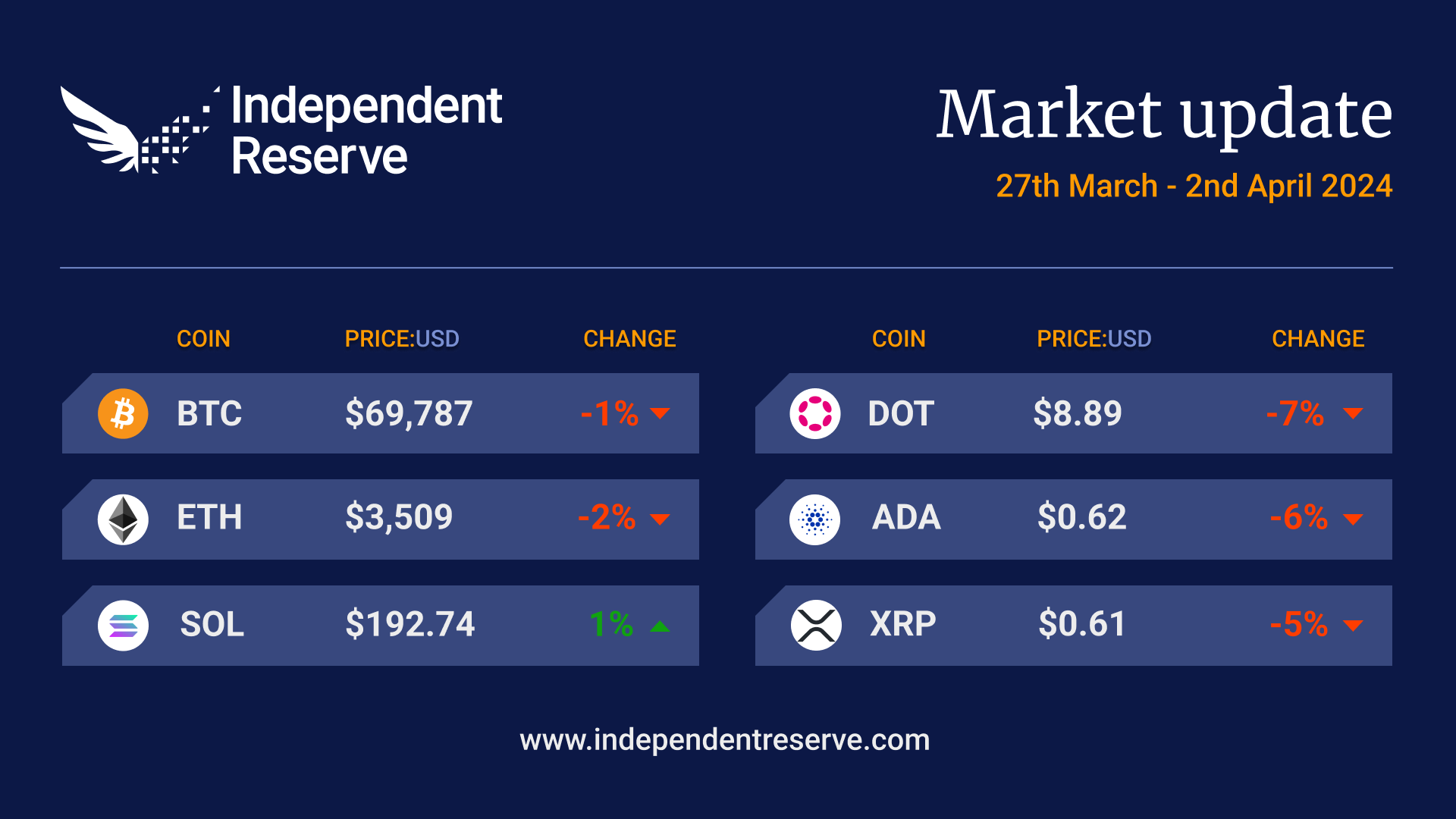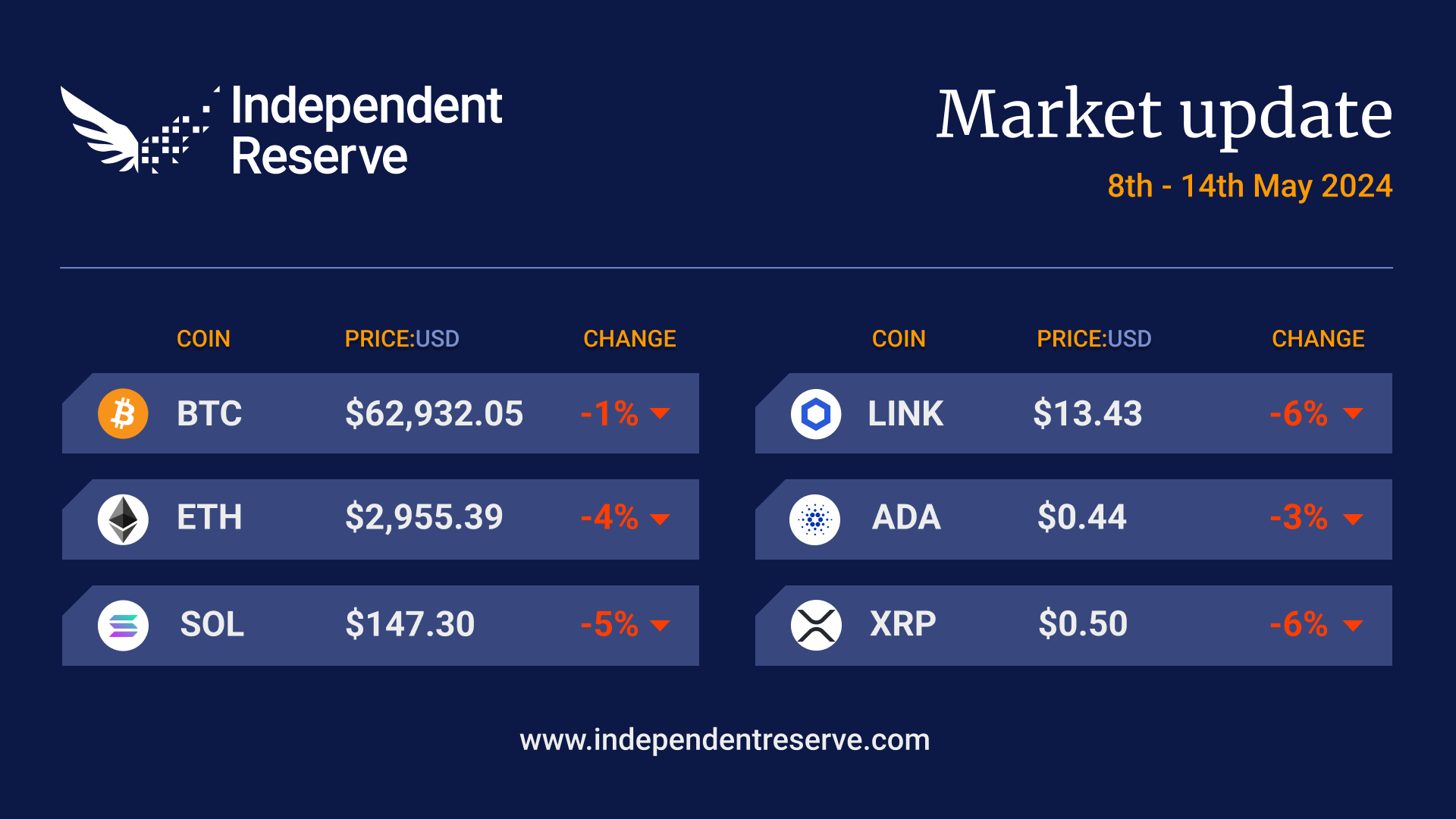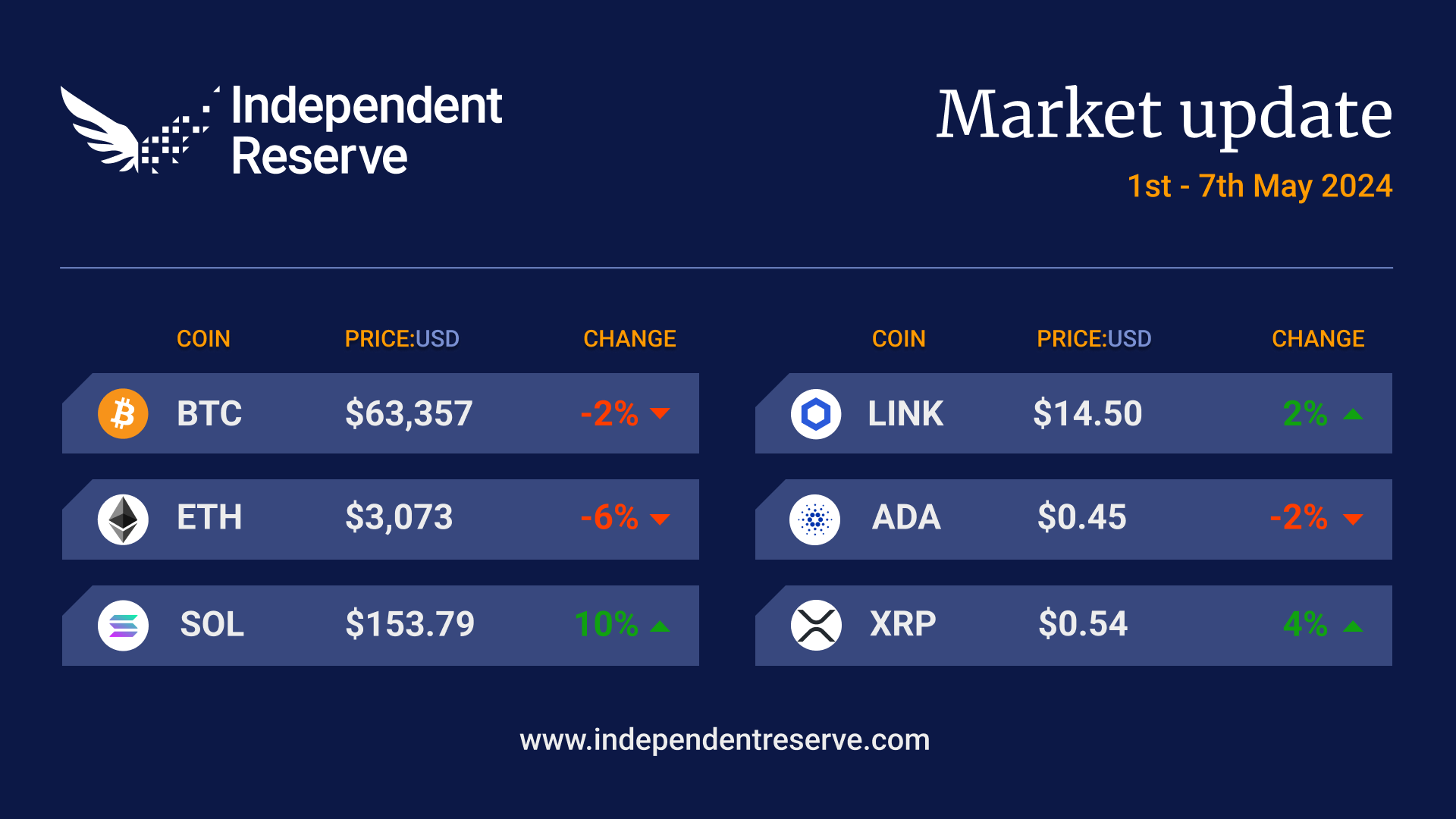In Markets
Bitcoin closed out the month and the quarter above US$70K (A$107.6K) for the first time — that’s higher than the 2021 peak. The halving is less than three weeks off, and the stars are aligning for the bulls. However, this cycle is very different, with Bitcoin hitting a peak prior to the halving for the first time, and the usual rotation into ETH and altcoins apparently skipped in favour of degens trading memecoins. Bitcoin finished the week down 1% on seven days ago at A$107,570 (US$69,753), while Ethereum eased back 2% to A$5,388 (US$3,500). Solana gained 1%, XRP dropped 5%, Dogecoin gained 15.7%, and RektCapital believes it’s now in a “macro uptrend.” The analyst also predicts a bright future for Shiba Inu (-1%). April is usually a good month for crypto prices, with Bitcoin’s historical increase averaging 14.03% while ETH usually increases by 23.97%. The Crypto Fear and Greed Index is at 79, or Extreme Greed.

From the IR OTC Desk
Post the Easter holiday period, cryptocurrencies have remained in a holding pattern. This holding pattern coincides with the halving – which is expected to take place on the 19th of April. While cryptocurrencies broadly remain within their most recent range, and the meme coin phenomenon continues to gyrate, broad undertones of inflation reacceleration are beginning to surface in the US pricing series. This is causing the forward yield curve to ‘change shape’ and for long end bonds to remain well anchored at their current levels.
The critical pricing data in last week’s economic calendar was US PCE inflation – the preferred measure of inflation for the US Federal Open Market Committee (FOMC). While appearing somewhat benign on the headline, US PCE inflation for February increased by 0.3% (MoM) and 2.8% (YoY) on the core reading. Critical to the underlying detail however, was an uptick in the January MoM release to 0.5% from 0.4% previously. The data, as well as the revision, represents an underlying core PCE run rate close to 3.5%. This is a long way from where the market had anticipated Q1 inflation when forecasting at the end of 2023, and while not necessarily an immediate concern for the FOMC, the inflation picture remains well away from their 2% mandate.
It is now 29 days until the next FOMC meeting, which is scheduled for the 30th of April/1st of May. It is the following meeting, however, on the 12 June, where the Committee will again update their inflation forecasts – and will likely have to take into consideration this reacceleration. Currently, the interest rate market sees June as the first ‘live’ meeting with a near 50/50 chance of a 25bp interest rate reduction. It was only last week that this expectation was closer to 75% for June! Watch this space.
On the OTC desk, the Easter period has caused a slowdown in trading volume. It is unclear whether this relates to the holiday period locally, or whether a lack of price movement may also be a critical input. What has remained however, is interest in USDT, which continues to trade in good size (both buyers and sellers) particularly out of our Singapore office.
Over the last few weeks, we have seen substantial switching into smaller market cap tokens. This appears to have taken a breather, although it is our expectation that this activity will again pickup as we move nearer to the halving. With the halving just around the corner we remain in a holding pattern.
For any further information, please feel free to reach out.
In Headlines
Singapore investors are buying
The fourth Independent Reserve Cryptocurrency Index for Singapore found that 48% of investors surveyed plan to buy more Bitcoin in the next 12 months. Around 60% of Singaporeans now view Bitcoin favourably, and more than half are aware of the US Bitcoin ETF approvals. Investors with more than half their portfolios allocated to crypto are the most bullish, with 68% planning to buy more Bitcoin. Three-quarters of investors prefer to buy BTC directly via an exchange rather than through an ETF.
Bitcoin ETFs go positive again
The Bitcoin ETFs returned to positive territory last week, following an entirely negative week of outflows. In the four business days last week, the ETFs hauled in US$859.7 million (A$1.325B) with no net outflow days. They’ve also topped 500K in Bitcoin holdings. Fidelity has filed an S-1 application with the SEC to create a spot Ether ETF that includes the option to stake part of the funds. But Bitwise chief investment officer Matt Hougan thinks it would be better for the Ether ETFs to be approved in 12 months time, rather than in May, as TradFi is too focused on Bitcoin right now.
Twice as many halvings
The Bitcoin halving is around 19 days away and will see the rate of new Bitcoin issuance halve from 6.25 BTC down to 3.125 BTC. But another halving happens at the end of this week, for its errant relative Bitcoin Cash which split off in 2017 to pursue its big block vision. The hashrate for BCH has doubled this week, while the price has surged 31% to A$999 (US$648). Major proponent Roger Ver has just released a book, which may have contributed to the interest. Another fork called Bitcoin Gold sees a halving on April 23.
Legal blow 1: Custodia bank loses in court
A US Federal Judge has dashed Wyoming-based Custodia Bank’s hopes of getting a Federal Reserve master account and membership of the Fed. The judge rejected the crypto bank’s motion to overturn the refusal, saying the Fed is not required to give every eligible depository institution a master account, nor was there evidence the Fed Reserve Board of Governor pressured the Kansas City Fed branch to deny the application. Custodia is yet to decide whether to appeal.
Legal blow 2: KuCoin indicted
US Department of Justice officials have indicted crypto exchange KuCoin and its founders for “conspiring to operate an unlicensed money transmitting business”, violations of the Bank Secrecy Act, and for receiving and sending billions of “suspicious and criminal funds”. The Commodity Futures Trading Commission simultaneously charged the exchange with multiple commodities violations. With users flocking to the exits, the exchange announced a US$10M (A$15.4M) airdrop to convince them to stay.
Legal blow 3: Coinbase ruling
Coinbase’s motion to dismiss the SEC’s case against the exchange has been rejected by US District Court Judge Katherine Polk Failla. The opinion found the SEC had “sufficiently pleaded” the case that Coinbase was unlicensed and that its crypto-staking offering was actually an unregistered security. The judge rejected Coinbase’s argument the SEC had overstepped its authority under the Major Questions Doctrine, and suggested the SEC has simply been applying existing rules to crypto rather than creating new ones. “The SEC should be encouraged by many statements in the order as the case moves to the discovery phase,” said Joe Carlasare, co-chair of Amundsen Davis’s crypto group, who also believes the SEC now has the edge in the case. The only good news for Coinbase was the Judge rejected the SEC argument that Coinbase Wallet (and similar self-custody wallets) is a form of brokerage activity.
SBF gets a quarter of a century behind bars
FTX and Alameda founder Sam Bankman Fried has been sentenced to 25 years in prison for his role in the multi-billion dollar fraud. The judge found he also committed witness tampering and perjury. He is expected to serve his time at a medium to low-security prison and may be released five or more years early. The judge was not impressed with defence arguments that creditors will get their funds back (at the value of the time of the collapse) thanks to the subsequent run up in crypto prices. “A thief who takes his loot to Las Vegas and successfully bets is not entitled to a sentencing reduction,” he said.
Ethereum L2s are not decentralised
NFT gaming project Munchables was hacked for US$62 million (A$95.6M), possibly by a lone hacker connected to North Korea, reportedly posing as four separate devs for the project. While the hacker is returning the funds after it became clear he could not get away with it, there was a heated debate over whether the Blast team should use its admin keys to zero out the transaction. This highlighted the fact that none of the Ethereum L2s are even vaguely decentralised at this point, with the best of the bunch, Arbitrum, still at ‘Stage 1’ decentralisation, which is a long way from the goal. Ethereum creator Vitalik Buterin, put out an important high-level summary of ETH’s future this week and called on all L2s to at least hit Stage 1 by the end of the year or be shunned by the community. He also called on devs to start designing applications and tokens with a “2020s Ethereum” mindset that embraces L2s, privacy, account abstraction and more, and put out a separate post about “the Purge”, which will remove unnecessary complexity from the chain and reduce the need for every node to store all of the old data.


